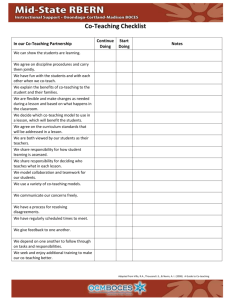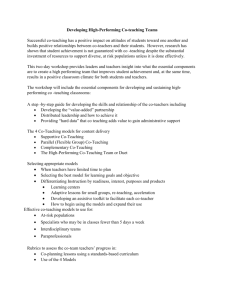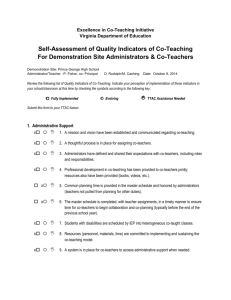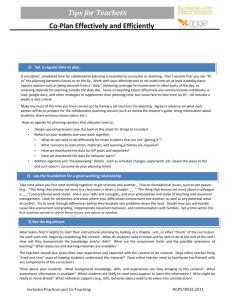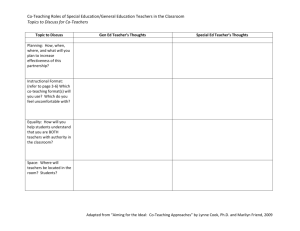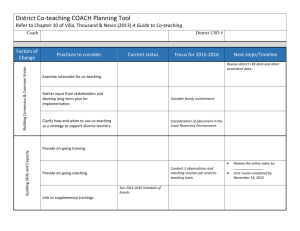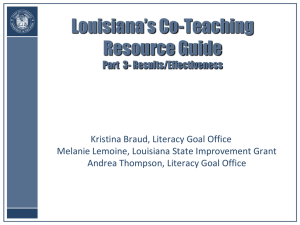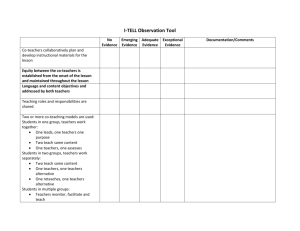Easton Co-Teaching Workshop January2016
advertisement
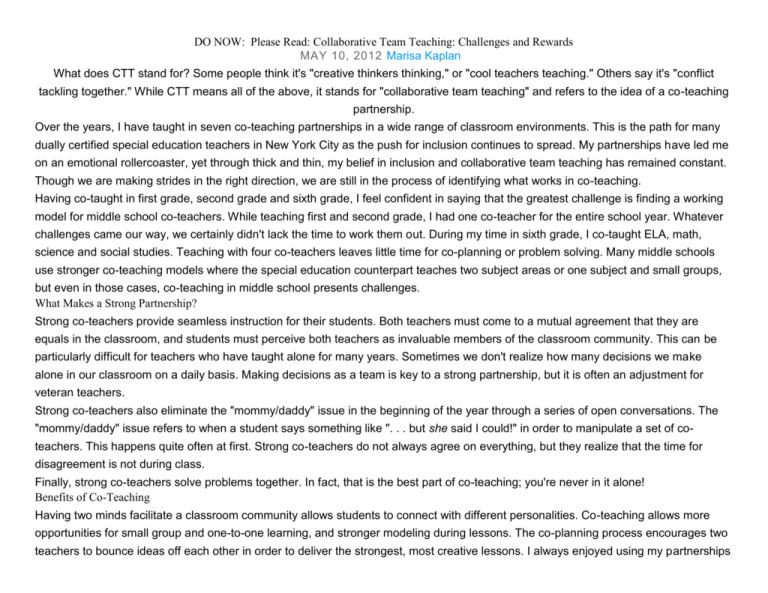
DO NOW: Please Read: Collaborative Team Teaching: Challenges and Rewards MAY 10, 2012 Marisa Kaplan1 What does CTT stand for? Some people think it's "creative thinkers thinking," or "cool teachers teaching." Others say it's "conflict tackling together." While CTT means all of the above, it stands for "collaborative team teaching" and refers to the idea of a co-teaching partnership. Over the years, I have taught in seven co-teaching partnerships in a wide range of classroom environments. This is the path for many dually certified special education teachers in New York City as the push for inclusion continues to spread. My partnerships have led me on an emotional rollercoaster, yet through thick and thin, my belief in inclusion and collaborative team teaching has remained constant. Though we are making strides in the right direction, we are still in the process of identifying what works in co-teaching. Having co-taught in first grade, second grade and sixth grade, I feel confident in saying that the greatest challenge is finding a working model for middle school co-teachers. While teaching first and second grade, I had one co-teacher for the entire school year. Whatever challenges came our way, we certainly didn't lack the time to work them out. During my time in sixth grade, I co-taught ELA, math, science and social studies. Teaching with four co-teachers leaves little time for co-planning or problem solving. Many middle schools use stronger co-teaching models where the special education counterpart teaches two subject areas or one subject and small groups, but even in those cases, co-teaching in middle school presents challenges. What Makes a Strong Partnership? Strong co-teachers provide seamless instruction for their students. Both teachers must come to a mutual agreement that they are equals in the classroom, and students must perceive both teachers as invaluable members of the classroom community. This can be particularly difficult for teachers who have taught alone for many years. Sometimes we don't realize how many decisions we make alone in our classroom on a daily basis. Making decisions as a team is key to a strong partnership, but it is often an adjustment for veteran teachers. Strong co-teachers also eliminate the "mommy/daddy" issue in the beginning of the year through a series of open conversations. The "mommy/daddy" issue refers to when a student says something like ". . . but she said I could!" in order to manipulate a set of coteachers. This happens quite often at first. Strong co-teachers do not always agree on everything, but they realize that the time for disagreement is not during class. Finally, strong co-teachers solve problems together. In fact, that is the best part of co-teaching; you're never in it alone! Benefits of Co-Teaching Having two minds facilitate a classroom community allows students to connect with different personalities. Co-teaching allows more opportunities for small group and one-to-one learning, and stronger modeling during lessons. The co-planning process encourages two teachers to bounce ideas off each other in order to deliver the strongest, most creative lessons. I always enjoyed using my partnerships to model behavior and positive peer-to-peer interaction for students. When students experience their teachers working together, they understand the power of respect amongst peers. Let's not forget the most important part: it is nice to have another adult in the room! One year, I taught with a co-teacher, a student teacher and four paraprofessionals. While things got a bit hectic at times, I loved the community we were able to develop in our class. Teaching is overwhelming, but co-teaching can provide a support system so that we can do our jobs, yet remember to have fun along the way. Common Challenges of Co-Teaching Co-teaching has its benefits, but be sure to understand that it has its challenges as well. The most common complaint I've heard from colleagues in co-teaching partnerships is that it is difficult to work with someone whose teaching style and philosophy differ from your own. In my own experience, success is less dependent on similar philosophies and more dependent on an open mind and willingness to compromise. If you are in a co-teaching partnership with someone who views learning and teaching differently, make sure to talk about it. Look at it as a chance to widen the scope of your practice by incorporating multiple styles into your teaching. Another common challenge is in regards to the inequality that often forms in the classroom. Special education teachers often struggle to present themselves as equals to their students, and this becomes even more evident in the middle school setting. Elementary coteachers share a classroom all day, but a middle school special education teacher can feel like a guest in a general education teacher's space. It is crucial to have conversations with your co-teacher surrounding these issues. Setting up the classroom with your co-teacher in September can help build a strong foundation for an equal partnership. Practicing a variety of co-teaching models also helps foster equality. A challenge that followed me through many of my partnerships was the issue of grading. Do you grade all students together? Does the special education teacher grade all students with IEPs? Does the general education teacher truly understand the purpose and implications of an IEP? These are all important questions to ask. I have found that it works best when you discuss this issue at the beginning of the year. While more time-consuming, grading all students together as co-teachers is the most fair and consistent way to grade. Grading together allows the special education teacher to share his or her expertise in IEP goals with the general education teacher, and it allows the general education teacher to weigh in on IEP goals for his or her students. Five Tips to Becoming a Strong Co-Teacher 1. Say this mantra: "All students are our students." 2. Come to planning meetings prepared (with an agenda) to maximize co-planning time. 3. If you feel something, say something! Open communication is the key to a successful partnership. 4. Realize that the success of your class depends on the strength of your co-teaching relationship. 5. Use a variety of co-teaching models to help maintain equality. STRENGTHS AND CONCERNS SURVEY What Are the Strengths and Concerns of Our Co-Teaching Team? Check the appropriate column. Take this survey as individuals initially, then work with your co-teacher on the two questions at the bottom of the page Essential Element Description Totally True Somewhat Not Yet True The Partnership Both co-teachers have equal voice in the planning, teaching, and grading Collaborative Relationship The Partnership: Both co-teachers are seen as experts in the classroom Expertise of Co-Teachers is fully used The Partnership: Has Parity Both teachers share the classroom space, all students, and decisions equally The Partnership: When there are differences of opinion, the issue is directly Has a Plan to Resolve Conflict. confronted as soon as possible Time for Collaboration is Provided The district provides definite planning time during the school day. The Classroom Climate Supports Co All students ask questions of both co-teachers equally teaching Practices The classroom has a balance of all levels of achievement; The Classroom Is Heterogeneous it’s not a “low level” class The Classroom Has Appropriate Co-teaching is completely supported with materials for all Space and Materials students Whole class teaching with the co-teacher assisting is NOT The Classroom: The Co-teaching Models Are Varied the main model The Whole School Climate Supports It is clear that the co-teaching model is considered an Co-teaching, Inclusion and Teaching important support both for students with needs and for All Students. general education student. TOTAL EACH COLUMN What are the major strengths of your team? (List them in priority order) 1. 2. 3 What are the major concerns of your team in priority order? 1. 2. 3. Your notes GROUP 1: WHOLE CLASS Model I: Supportive Co-Teaching (Whole Group): One Teaches/One Observes Strengths: This supportive model is good to use as the co-teachers begin a new co-teaching relationship to allow a new co-teacher to observe the classroom of her colleague This model can be used occasionally to focus on a specific aspect of the class or a specific student with a planned sharing of observations to consider possible instructional interventions or modifications. Those interested in learning more about effective peer observation may wish to read the peer observation section found in chapter 11 of this book. Co-teachers can alternate the teaching and observing roles to gain better understandings of the class and its individual students as well as of the teaching style, strengths, and expertise of their co-teacher Co-teachers can use this model to observe one another and provide valuable feedback on their teaching. Those who wish to learn more about peer observation should read the peer observation section in chapter 11. Challenges: Unless these two leading and supporting roles are reversed the Specialist Educator (SE) can become more of an instructional aide. If this method is used because of a lack of co-planning time, the SE may not clearly understand the goals of the class This model may become an “ad hoc” partnership that lacks long-term shared goals and, as a result, lacks depth. The skills of the second teacher may not be fully used throughout the class and may be limited to her target students or students who ask for her assistant Model I: Supportive Co-Teaching (Whole Group): One Teaches/One Drifts Strengths: This whole class model is useful as the co-teachers are establishing a co-teaching relationship and the new co-teacher observes the classroom This model can be used occasionally when one teacher is directly teaching and the other gathers data and assists students throughout the lesson Co-teachers can alternate the teaching/drifting role to signal shared responsibility for teaching all students Challenges: If this model is the favored model for co-teaching, it can indicate that direct teaching is the primary instructional method Unless these two leading and supporting roles are reversed, the SE can become more of an instructional aide. If this method is used because of a lack of co-planning time, the SE may not clearly understand the goals of the class This model may become an “ad hoc” partnership that lacks long-term shared goals and lacks depth. The skills of the second teacher may not be fully used throughout the class and may be limited to her target students or only students who ask for help Model I: Supportive Co-Teaching (Whole Group): One Teaches/One Assists or Supports Strengths: This model is often the “default” model when the team does not have time to co-plan This model is typical when a content teacher teaches and plans in isolation and a special educator supports students at times without taking part in planning or goal setting This can be a useful model when the co-teachers have limited planning time or specialist does not work in the classroom every day After the direct teaching is concluded, both teachers assist and support students The assisting teacher can provide the teacher who is teaching with misconceptions or questions for students The assisting teacher can take notes or fill in a graphic organizer on the overhead while the other teacher teaches the lesson Challenges: This model may become an “ad hoc” partnership that lacks long-term shared goals and lacks depth. The assisting teacher can have a relatively passive role The skills of the second teacher may not be fully used throughout the class and may be limited to her target students or those who ask for help This model may become an “ad hoc” partnership that lacks long-term shared goals and lacks depth unless the team has time to collaborate Model I: Supportive Co-Teaching (Whole Group): Adapting Curriculum Approach Strengths: One teacher takes the lead and the other makes modifications as the occasion presents itself perhaps because of a student’s look of confusion or a specific question Co-teachers may develop a tool kit that can be used to support needed adaptations or modifications for specific students which may include sticky notes, index cards, manipulatives, highlighters, a calculator, a spell checker, for example The model requires very little planning time Roles are clearly defined with a lead teacher doing the majority of the teaching and a support teacher providing assistance only The method provides accommodations and the specialist is focused on her area of expertise Challenges This model may become an “ad hoc” partnership that lacks long-term shared goals and lacks depth. The skills of the second teacher may not be fully used throughout the class and may be limited to her target students GROUP 2: MODEL II; PARALLEL TEACHING: STATION TEACHING Model II: Parallel Co-Teaching (Small Group Instruction) In the Parallel Co-Teaching Model, both educators teach students at the same time. The activity within the groups distinguish each model. 1) In Station Teaching student groups move through two or more learning stations two of which are taught or facilitated by one of the co-teachers. If the classroom have more than two stations, students will be able to navigate the independent tasks without teacher direction either because the station is part of a familiar classroom routine of the task is clearly explained by the instructions at the station. For example, the station could be a computer or group of computers and the student group could work through a program on which they have had prior experience or the station could be a video which the student group views and takes note. Model II: Parallel Co-Teaching (Small Group Instruction): Station Teaching Strengths: Learning centers are used to organize the classroom; students are divided into groups of from two to six and they rotate through the centers, working at times with a teacher teaching or facilitating, or working independently and receiving support when needed. For example, a third grade class might be working on writing a summary based on informational text. at one station, a co-teacher could read a short passage that students collaboratively summarize, a second co-teacher might work on a longer passage and teams of 2 students might summarize a different paragraph and share their summary with the rest of the group, a third station might an informational passage already on a bank of 2 computers and students in 2’s summarize the paragraph, and finally a group of students might read an example summary and evaluate it using a rubric. Each center focuses on a skill or on content that may have multiple levels or alternatives for response for differentiation among the groups Each center can provide differentiated and focused learning for support, reinforcement, or acceleration This model can provide access for all students to curriculum through differentiation of the centers The stations must be carefully planned. The stations can be self-directed by individual or groups of two students work together. If all of the stations are self-directed, teachers may circulate to provide support when it is needed. Thus, teachers’ roles vary in station teaching. and each teachers may facilitate a specific center, provide requested support, or circulate among all groups, Challenges: If centers are provided for “at risk” students only, centers may appear to be remedial and not a kind of differentiation for all students This method is time intensive in the preparation of materials and the planning for the needs of all students. If these centers are developed separately, one for GE students and the other for SE students, the coteachers may be teaching two classes, but in one classroom. As a result, there may not be a real partnership between the teachers if the groups are not co-planned and are always divided into GE and SE students GROUP 3: PARALLEL TEACHING 2 GROUPS In this Parallel Teaching model, each educator teaches a different lesson to a group Model II: Parallel Co-Teaching (Small-Group Instruction): Each Teacher Teaches a Group Strengths: The class is carefully divided into two groups either heterogeneously or homogeneously based on need, for example, in a middle school mathematics class, students who are having difficulty with ratios might be in one group while another group may be focusing on solving word problems about ratios The same collaboratively-planned content is taught by each co-teacher possibly with each lesson taught on different levels of difficulty The small groups provide for more student and teacher interaction The model requires equal expertise if both co-teachers are teaching the same material Challenges: This model may actually function as two separate classrooms held in one class if the groupings are always based on readiness or level of challenge or if GE and SE students are always in separate groups There may not be a real partnership between the teachers if they plan separately for their SE or GE students all of the time. GROUP 4: PARALLEL TEACHING ALTERNATIVE C0-TEACHING, SKILL GROUP TEACHING, AND LEARNING STYLES In Alternative Co-Teaching one group is smaller and is generally taught by the specialist whose lesson is focused on specific targeted students; Model II: Parallel Co-Teaching (Small-Group Instruction): Alternative Co-Teaching Strengths: Generally the class is divided into a larger and a smaller group with the smaller group generally needing more intensive support, for example, a small group of students may need re-teaching. The larger group may be going more deeply into a concept. For example, in a middle school English class that just finished writing an argument, the students who had difficulty with their conclusions might be in a small group looking at samples of good conclusions and working collaboratively to improve their own essays while the larger class might use the class rubric to assess sample papers and then to work collaboratively to improve their essays. Both teachers may work with each group alternatively in which case each educator teaches her unique content or each teacher may stay with one group The smaller group participants change for different purposes including pre-teaching, re-teaching, and enrichment This model is generally used for a short period of time Challenges: This model may actually function as two separate classrooms held in one class if the groupings are always based on readiness or level of challenge or all of the students are divided into GE and SE students There may not be a real partnership between the teachers if this type of lesson is planned separately Model II: Parallel Co-Teaching (Small Group Instruction): Skill Group Teaching Strengths: Students are grouped according to their need in specific skills could be taught by either co-teacher At times this model is based on a 2- or 3-day co-teaching model when the SE teacher reteaches skills not yet mastered. In this case, the roles of the co-teachers would be unbalanced because the specialist would work with only part of the class This method saves time especially if specialist is not in the classroom daily Multiple ability levels are addressed by dividing the groups into skills Challenges: This model may actually function as two separate classrooms held in one class if the groupings are always based on readiness or level of challenge There may not be a real partnership between the teachers if the specialist is only planning for the target students Model II: Parallel Co-Teaching (Small Group Instruction): Learning Styles Approach Strengths: Both teachers support effective learning by providing re-teaching using multiple modalities, for example, hands-on or visual re-teaching All learning modalities are included: visual/auditory and tactile/kinesthetic This model is generally used occasionally Challenges: If this model is the usual model, the classroom may actually function as two separate classrooms if the modalities address only the re-teaching of the target students There may not be a real partnership between the teachers if this is the only method used GROUP 5: COMPLEMENTARY TEACHING AND THE DUET MODEL Model III: Complementary or Side-by-Side Teaching In the following two models, the teachers work together as equals. In the Speak and Add Model, the second teacher may provide support and take notes on a smart board, provide scaffolding for the whole class, or may ask questions that students may have. Also, teachers may switch roles. In addition, the second teacher may be a second content teacher in an interdisciplinary class who adds her content to the content of her coteacher. In the Duet or Team Co-Teaching model, both teachers are master co-teachers and function as a high-performing team. Each teacher is able to provide both content and support to all students. The Duet or Team Co-Teaching form of co-teaching requires planning time. The difference between the two forms of Model III is the level of expertise in co-teaching of the teachers of the two models. In the former Speak and Add Model, generally teachers are teaching the whole class together as equals. Interdisciplinary teachers may use this model when most of their teaching is direct teaching. On the other hand, the Speak and Add co-teachers may be just beginning to co-teach or they may have been working together as co-teachers for a long period of time. The high-performing Duet or Team Co-Teaching Team does not just use the whole class model, but uses all of the models, whole group, small group, and complementary. The Duet or Team Co-Teaching model is called high performing because it is the most intensive of all of the models. It requires time for co-planning and for communication. It also provides the most support for students. Model III: Complementary: Speak and Add Model (Whole Class) Strengths: One teacher takes the lead and the other teacher adds to the lesson with graphic organizers, examples, questions, ongoing assessment, and support In an interdisciplinary co-teaching class, each teacher may contribute his content area’s knowledge This model can be used as a beginning stage of co-teaching while the specialist gains knowledge of the content and the GE teacher’s style This method takes little time in co-planning and is easy to implement Challenges: This model can underutilize second teacher (specialist) if this teacher is always “adding” This model may become an “ad hoc” partnership that lacks long-term shared goals and lacks depth. The skills of the second teacher may not be fully used throughout the class and may be limited to her target students Model III: Complementary: Duet or Team Co-Teaching, A High-Performing Team Strengths: Duet teachers co-plan and make instructional decisions to work with small groups, individuals, or the whole class based upon ongoing assessments throughout the class Both educators employ general and SE techniques to support the progress of all students This model is the most completely integrated for students and fully utilizes all expertise of each coteacher This method is the most time intensive because extensive planning and communication is essential This method provides the most support for students The roles of the GE teacher and specialist are indistinguishable (Beninghof 2012, 55-58) Chapman and Hyatt call this method “Walking the Talk” because all of the models are used as appropriate for the class. Teachers facilitate whole and small groups, have stations that are independent and facilitated, and they differentiate for all learners This model’s organization is based on student goals and needs. Challenges: The model takes time for planning, time for balancing the two teachers’ relationship, responsibility, and trust; it requires interdependence The model needs administrative and whole-school support and a school-wide commitment to both inclusion and to high expectations for all students This method puts the greatest stress on the relationship In addition to the time spent planning for the classroom, the partners need to spend time on their partnership and its development. According to Chapman and Hyatt, co-teachers need to have 4 ongoing critical conversations about their relationship and their classroom. The topics should include the following four topics that are sustained throughout the co-teaching partnership. Co-teachers need to consistently revisit and reflect on how they: 1. Define the Partnership: Partners develop a shared vision, establish roles and responsibilities, and lay the collaborative foundation that may need adjusting throughout the year 2. Examine Data: Together they focus on results, use data about students to make instructional improvements and become more adept at adjusting materials and instruction to support each student 3. Enhance Instruction: They focus on ways to provide more value as a twosome than one teacher could do alone and continue to learn together about research-based methods that work for their students 4. Expand Impact: They recognize that they are part of a school system and that they need to have administrative support for their work together and for professional development that will support the school and the team’s capacity for improving instruction (Chapman and Hyatt 2011, 10-11). According to Chapman and Hyatt, models need to be addressed, but the true value added component of co-teaching comes from the partnership’s growth which will take place over time as the four areas listed above are consistently considered, critically and reflectively, during the co-teaching meetings and in the classroom. Planning—Sharing Responsibilities Teacher A Teacher B Shared Concerns, Notes Planning for the year Planning for the week Preparing materials Grading tests, quizzes, classwork, homework Collecting, organizing and analyzing data Classwork, homework, observations, formative and summative data Classroom routines (attendance, make-up work, passes, behavior problems, meetings, schedules, IEPs, team meetings) Our 2 PD goals for the year Our scheduled meeting days/times for the year Planning--Agenda Meeting Date Minutes Recorded by: Time 5 min 5 min 5-10 min 30 min 10 min 5 min People Present Follow-Ups necessary: AGENDA Review Agenda and Positive Results since the last meeting Review the Co-Teaching Progress Rubric/Tracker to make sure you keep all of your priorities in focus Review student needs, student work, student data Plan for the next week using agreed-upon weekly lesson planning document or daily lesson planning document Review tasks for participants for the next week Plan for next meeting: time, place, participants, topics Planning: Lessons (Quick Form) Day of week/ Content Whole Class: One teach/One observes One teaches/One drifts One teaches/One assists or supports One teaches/One adapts the curriculum Small Groups Small Group Materials, Tasks Teacher A Materials Tasks Teacher B Parallel Teaching Alternative Skill Group Learning Styles Stations Monday Content: Tuesday Content: Wednesday Content: Thursday Content: Friday Content: Techniques Skills Survey . Content areas of classroom Flexible grouping, cooperative learning Making groups accountable Teaching reading, writing, or specific skills Developing a positive classroom environment Routines for classroom (attendance, bathroom passes, transitions, passing out paper, make-up work) High expectations for all Grading with another teacher Major Strength Some Strength I could learn something about This is a challenging area that I could learn about Modification of lessons for specific needs Designing scaffolds to support specific learner needs Differentiating for different learners Developing challenging and engaging units Positive behavior supports IEP Goals and progress monitoring Creating a challenging yet safe environment for learning Using data to make decisions about curriculum, instruction, assessment, and specific students Specific district or school Initiatives such as project-based teaching, Response to Intervention, data analysis, curriculum based assessment, etc. Technology: Data bases, assessment, web-site design, behavior software Sample Middle School ELA Teacher and Special Educator Weekly Lesson Outline Day of week/ Content Monday Content: Creating a Graphic Novel about the Hero Tuesday Content: Creating a Graphic Novel about the Hero Whole Class: One teach/One observes One teaches/One drifts One teaches/One assists or supports One teaches/One adapts the curriculum Small Groups Small Group Parallel Teaching Alternative Skill Group Learning Styles Stations Materials, Tasks Middle School ELA teacher Materials Tasks Middle School Special Educator Writer’s Workshop Hero Graphic Novel writing in groups of 4: Roles: Plotter, Storyboard drawing, Dialogue, Publisher Mini-Lesson: Storyboard Conference with Group DEF about plot and examples visuals Conference with Group ABC about plot and visuals Small group models Writer’s workshop Drafts due Conference with Group ABC about rubrics Mini-lesson: Final product: example use rubric Conference with Group DEF about rubrics Wednesday Content: Reading Hero Novels Thursday Content: Reading Hero Novels Friday Content: Present and Evaluate Writing on Heroes Literacy Circles: Hero Theme Literacy Circles Hero Theme Whole Class Present 6 groups share graphic novels Shared Rubric Carousel—Using rubric Awards for Best of Criteria of Rubric: Best Plot, best Story Board, Best Dialogue, Best as whole Mini lesson in group G the hero’s journey Reading more challenging book Mini lesson in group G (Reading more challenging book) Demonstrate Rubric/Voting on Comic Mini lesson in group H the hero’s journey Reading easier book Mini lesson in group H the hero’s journey (Reading easier book) Demonstrate How Carousel works Class Norms Positive comments We’re all learning Appreciate the strengths of one another Grade—Best in gets “prize” from classroom box Grade—based on rubric Unit/Lesson: Middle School World Studies (Interdisciplinary) War: Causes and Effects: The French Revolution Standard(s) (District or State) HSS: Massachusetts History Curriculum World History WHII.3 Summarize the important causes and events of the French Revolution. (H, C, E) Causes: A. the effect of Enlightenment political thought B. the influence of the American Revolution C. economic troubles and the rising influence of the middle class D. government corruption and incompetence Events: A. the role of the Estates General and the National Assembly B. the storming of the Bastille on July 14, 1789 C. the 1789 Declaration of the Rights of Man and the Citizen D. the execution of Louis XVI in 1793 E. the Terror F. the rise and fall of Napoleon G. the Congress of Vienna World History II.4 Summarize the major effects of the French Revolution. (H) A. its contribution to modern nationalism and its relationship to totalitarianism B. the abolition of theocratic absolutism in France C. the abolition of remaining feudal restrictions and obligations D. its support for the ideas of popular sovereignty, religious tolerance, and legal equality Common Core for English Language Arts and History/Social Studies Literacy MA. Reading and Literature, 9-10. 8. A. Analyze a work of fiction, poetry, or drama using a variety of critical lenses (e.g., formal, psychological, historical, sociological, feminist). MA. Reading and Literature 9-10 History :Compare the point of view of two or more authors for how they treat the same or similar topics, including which details they include and emphasize in their respective accounts . Assessments: Formative: (observation, conference, quizzes, group work, rubrics) Observation: Discussion at the end of class on point of view, primary documents, literature, and popular plays and point of view. Formative: Hand in the notes from the musical: how the poor and the aristocrats were represented Observation by each teacher: Discussion and activities when they met with each of the three groups. Summative: (test, performance-based task, etc.) They will present the French Revolution from three points of view: the poor, the aristocrats, and “fact finders.” Sequence of Lesson/Activities: How will you support and scaffold students’ learning as they move toward mastery? 1Whole class introduction/mini-lesson, etc.: Whole class description of the three groups and their responsibilities. 2Flexible group activities: Students move from group to group every 25 minutes. 3Wrap-up3Evaluation (exit slip, hand in work, observation, quiz, etc.) Final discussion. Co-teaching Model Supportive Model (Whole Class) X Parallel Model (Small Groups) Complementary/Side-by-Side (Whole Class) John’s Responsibilities 1. Co- Explain the 3 groups 2. Materials for primary source about the poor activity 3. Co-Lead final discussion Collect students’ notes Celeste’s Responsibilities 1. Co- Explain the 3 groups 2. Materials for novel activity 3. Co-Lead final discussion Collect students’ questions Grouping Strategies (Seating Arrangements) Random grouping: count off by 3’s and move from group to group every 25 minutes and gather together at the end of class to discuss the three activities. . Group A Students Random Group B Students Random Group C Students Random Modifications None Modifications None Modifications None Assessment Observation in HSS or ELA group and at end of class Evaluate quality of questions using rubric Assessment Observation in HSS or ELA group and at end of class Evaluate quality of questions using rubric Assessment Observation in HSS or ELA group and at end of class Evaluate quality of questions using rubric Developmental Continuum of a High Performing Team Use this form to set goals and monitor progress—Use highlighter to indicate all descriptors that apply. Criteria Partnership Novice Begin Develop Begin to set goals using Co-Teaching Progress Rubric/Tracker Begin to clarify on roles and responsibilities using Teacher Skills Survey Begin to set standards for classroom routines, behavior using the Roles and Responsibilities Matrix Developing Fairly Generally Mainly Proficient Generally consistently Generally effectively Generally reliably Measure progress on goals fairly often and adequately Roles and Resp. getting clarified Norms generally observed Meetings mainly effective Problem solving protocol mainly works Daily/weekly communication plan mostly works Other: Measure goal progress generally consistently Roles and Resp. generally consistently clarified Norms observed generally consistently Meetings generally are effective Problem solving protocol works generally effectively Daily/weekly communication plan generally works reliably Other Develop daily/weekly communication plan Co-planning Begin to plan for full year’s meeting schedule Develop agenda format Develop Lesson Plan format (long form) Develop weekly lesson plan format (short form) The full year’s meeting schedule mainly works The agenda format mainly works Lesson Plan format (long form) mainly works Weekly lesson plan format (short form) mainly works High-Performing Team Consistently Mutually Wholly Naturally Goals are mutually shared and measured by each teacher and team consistently Roles and Resp. consistently clarified Norms observed consistently Meetings consistently effective Problem solving protocol works well consistently Daily/weekly communication plan consistently works efficiently Other The full year’s meeting The full year’s meeting schedule generally works schedule works effectively effectively and consistently and consistently The agenda format The agenda format works generally works effectively effectively and consistently and consistently Lesson Plan format (long Lesson Plan format (long form) works effectively form) generally works and consistently effectively and consistently Next Steps for HIGH priority Selecting NOTE: Date each comment Co-teaching Coassessing and cograding Models Used are Highlighted Whole Class: One teach/One observes One teaches/One drifts One teaches/One assists or supports One teaches/One adapts the curriculum Small Group Parallel Teaching Alternative Skill Group Learning Styles Stations Duet All models Begin to assess students’ work together and to set mutually agreed upon standards Begin to develop rubrics, scoring sheets together Weekly lesson plan format (short form) generally works effectively and consistently Weekly lesson plan format (short form) works effectively and consistently Models Used are Highlighted Models Used are Highlighted Models Used are Highlighted Whole Class: One teach/One observes One teaches/One drifts One teaches/One assists or supports One teaches/One adapts the curriculum Small Group Parallel Teaching Alternative Skill Group Learning Styles Stations Duet All models Assess all major assignments together Use mutually developed rubrics Rubrics can include modified work Do report cards and progress reports together and mainly agree Whole Class: One teach/One observes One teaches/One drifts One teaches/One assists or supports One teaches/One adapts the curriculum Small Group Parallel Teaching Alternative Skill Group Learning Styles Stations Duet All models Assess together Use common rubrics Grade report cards and progress reports together Use results to plan for the next week or unit Whole Class: One teach/One observes One teaches/One drifts One teaches/One assists or supports One teaches/One adapts the curriculum Small Group Parallel Teaching Alternative Skill Group Learning Styles Stations Duet All models Assess together with rubrics that are mutually created Grade together Use classroom results to develop flexible groups and to modify instruction for the week and for the year Using Data Examine standardized assessments, IEPs, and previous grades together Use these assessments to set goals and plan for year Student work is used at the end of each marking period to assess the effectiveness of teaching and to set goals for the next quarter Consistently use classroom assessments formatively to modify groups and plans to differentiate instruction Begin to track at risk students’ progress Improving Practice This rubric is used to assess present state of and to assess growth in differentiating instruction, developing group work, formative assessment of student work to adjust curriculum, IEP goals, UDL, RtI and/or local or self-selected PD initiatives using the Co-Teaching Progress Rubric Co-teachers look at the status of school-wide inclusion: principal support, teacher attitudes, teacher support, time allotted, progress, needs Differentiating instruction is begun in parallel groupings include flexible groups that reflect need, interests, self-selection, learning styles, stations, etc. Co-teachers have begun to work on new-to-one or both co-teachers specific PD or initiatives The DI groupings are varied as need is demonstrated in the class. UdL, RtI, and/or specific local initiatives are generally employed in planning and teaching Co-teachers begin to discuss the status of school-wide inclusion with administrators and teachers Co-teachers provide regular feedback to administrators and teachers about the status of inclusion. They may provide workshops in the school. School-wide Inclusion Data from observations, behavior, classroom assessments, qualitative and quantitative are used consistently and effectively to plan and to monitor student progress throughout the year. Universal Design for Learning, Differentiating Instruction, Response to Intervention, and other local or team-based PD are consistently to support effective teaching and progress monitoring for all students. Co-teachers advocate for inclusion and provide regular feedback to administrators and teachers about the status of inclusion. They may provide workshops in the school.
